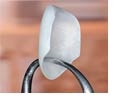
In the face of growing dental technology it’s important not to get caught up with wow factors, gimmicks, or the latest trends when it comes to cleanings. A good hygienists’ primary goal is to help preserve the health of your mouth despite the neat-o tools available. Not that the latest and greatest isn’t out there, but make sure the one that has won you over really works.
Assess the effectiveness of your cleanings with this brief overview of popular cleaning techniques:
A rubber cup and paste is great for two reasons. It removes soft deposits such as plaque and removes stain. The rubber cup or prophy cup is considered the primary tool used for a child cleaning. Children develop little or no tartar. Since the rubber cup does not remove tartar or calculus it should not be considered an acceptable tool for an adult prophylaxis. Only to remove stain at the end of a cleaning would this be beneficial.
Also referred to as an air polisher, the prophy jet removes some soft deposit, debris, and is great for removing stain, much like a rubber cup. It is mainly used as a polishing tool after your teeth have been cleaned. Instead of applying and abrasive paste to the tooth surface with a rubber cup, the prophy jet uses the force of air and water to polish with a fine powder abrasive. The jet is beneficial because it not only polishes the front and back surfaces of the teeth but often polishes the angles and in between them as well.
Hand scaling is where the hygienist uses metal and sometimes plastic instruments to remove deposits from the teeth. This is considered the standard for a cleaning. They rely on their tactile sense to locate and remove tartar, debris and plaque. It also enables the hygienist to thoroughly examine your teeth through sight, sound and feel.
An ultrasonic scaler can be more effective than hand scaling alone if used properly. The vibration of the instrument disturbs plaque formation and breaks up tartar on the teeth. The water flow washes the debris from the area while the oxygen from the bubbles kill bacteria. One major drawback is the inhibition of tactile sense due to the vibrations. It’s hard to know if all the deposits are gone and this is why hand scaling should be done after the ultrasonic scaler for a thorough cleaning.
Currently no dental laser cleans teeth. It cannot remove tartar or calculus from the tooth; this still has to be accomplished through traditional scaling. The laser does act as a temporary localized gum sterilizer if you will. It does reduce the bacterial levels, but treatments are always needed to keep the bacterial level down.
I know most people are getting the appropriate treatment, but there are some exceptions. Knowledge is empowerment. If you are unhappy with the cleanings, request a technique that suits you. I’m sure the hygienist will be happy to accommodate if possible. You should feel good knowing that you are in control of your oral health.

When I think of Lumineers®, I think of fake nails. You just glue them over your natural short stubby nails and whala, now you have beautiful long pretty nails. Lumineers work the same way. They are thin porcelain shells glued to the outside of your teeth. Lumineers® offer patients the opportunity to alter the appearance […]
Read More
Dental insurance is great. It’s even better when your company is paying for it. And like all great things, there are limitations. These limitations come in the form of money. Most dental insurance policies have a deductable, waiting period, a co-pay, an annual maximum, and limitations on x-rays, dental exams and cleanings. These policies are […]
Read More